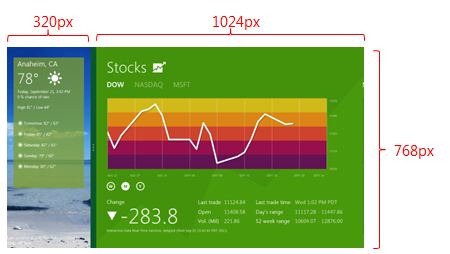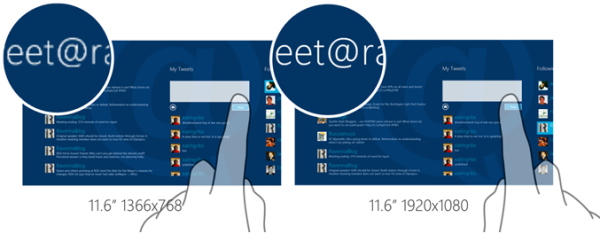Microsoft Talks Screen Resolution in Windows 8, Suggests "Retina"-esque Tablets
by Andrew Cunningham on March 22, 2012 10:30 AM ESTMicrosoft's David Washington has penned another informational tome on the Building Windows 8 blog, this one about Windows 8 and its support for varying screen resolutions. The above chart lists the common (but not the only) resolutions that Microsoft is planning for, and while most of the listed display types won't surprise anyone (wall-to-wall 1366x768 and 1920x1080 for most desktops and laptops), it does appear as though Microsoft is planning for Windows tablets with a DPI that approaches or matches that of the new iPad.
Microsoft is planning for tablets that use both the 1024x768 and 1366x768 resolutions common in earlier and lower-end tablets as well as the high-DPI screens that are being (and will be) ushered in by the new iPad. To scale Windows elements so that they're still comfortable to look at and touch at these resolutions, Microsoft has put together some pre-defined scaling percentages: 100% when no scaling is applied, 140% for 1080p tablets, and 180% for quad-XGA tablets like the new iPad. These percentages were all chosen as "pixel density sweet spots" for 10" and 11" tablets with 1920x1080 or 2560x1440 displays. It should be noted that Washington's blog post focused entirely on Metro scaling - whether the Windows desktop will automatically scale using these percentages is unclear.
Microsoft's attention to these specific resolutions suggests that we will probably see some high-DPI Windows tablets when they launch in the fall, though we still don't know anything about the tablets OEMs are designing for Windows 8 and Windows on ARM. It's also telling that there are no 7" tablets on that chart - we may not see Windows versions of smaller tablets like the Kindle Fire or Nook Tablet.
Washington went on to explain the reasoning behind the minimum resolution requirements for Metro apps that we noticed in our Windows 8 preview review - 1024x768 for Metro apps and 1366x768 for the Metro Snap feature. Both choices were largely developer and data-driven: 1024x768 is a common low-end resolution for web developers and tablet app developers, and Microsoft didn't want to restrict these developers to a lower minimum resolution to account for the small percentage of 800x600 and 1024x600 displays that are currently in use.

As for snapped apps: the size for a "snapped" app is always 320 pixels wide, which was again selected because developers have become used to it in their work with smartphones. A 1366x768 display is the lowest common screen resolution that allows for the 320 pixel width and the 1024 pixel minimum width for regular Metro apps.
Also discussed was the methods by which Metro allows programs to expand to take up all of the pixels in a larger laptop or desktop display: To help dynamically expand content to take up more screen space when the pixels are available, Windows 8 uses the same XAML and CSS3 features that are commonly used to accomplish this on modern web pages - examples of such features include the grid, flexible box, and multi-column CSS3 layouts. App templates provided with Visual Studio 11 all make use of these features automatically. Developers can also scale their apps to fit larger displays, which is useful for games or other apps that don't need to make use of additional pixels.
For more, including Windows 8's support for scalable graphics and the Windows Simulator tool that will provide Visual Studio 11 users the ability to test their apps at multiple screen resolutions, the full post is linked below for your convenience.
Source: Building Windows 8 blog











29 Comments
View All Comments
Spivonious - Thursday, March 22, 2012 - link
#1. The windows desktop has supported high DPI displays at least since XP, it's the desktop apps that don't always implement support for it. I anticipate this to continue.#2. The 320px wide area also scales, so it's 320 "device pixels" but not necessarily 320 "display pixels".
michael2k - Thursday, March 22, 2012 - link
Metro apps have something called Metro scaling, mentioned in the article, which at least alleviates the problem for apps available through the App Store for tablets and the Metro interface. This might actually fix the problem for desktops, too.Concillian - Thursday, March 22, 2012 - link
"This might actually fix the problem for desktops, too. "Holy hell, I hope so... it would be about time. We've only been struggling with this 'considerably less complex than rocket science' issue for 20 years or so.
My gut tells me there will still be plenty of ignorant software developers out there screwing this up for desktop users, though.
Chudilo - Friday, March 23, 2012 - link
Alternatively, you'd have to go the Apple route and not allow the software to run on your platform until they do things properly.choirbass - Sunday, March 25, 2012 - link
Concerning only downloadable app store applications where tablets and phones are concerned, most apps scale to the proper ppi. Thankfully the selection of capable software isn't nearly as limited, unlike has been the case for a long time with their desktops.KitsuneKnight - Thursday, March 22, 2012 - link
It's disappointing how desktop/laptop resolution has slowly slid back over the last decade. We're not at the point where Microsoft's _bottom tier_ tablet screen resolution will be superior to entry level desktop/laptops, and equal to the vast majority of them. And then, the high end for desktops/laptops (without being multiple feet in size) will be equal to the middle rung for tablets.I'm really hoping Apple puts out a "Retina"-style display on their next refresh of the Airs/MBPs, because it doesn't look like Microsoft or any of the PC manufacturers are interested in bumping the resolution of PCs.
Taft12 - Thursday, March 22, 2012 - link
The trend to lower resolution is disappointing, but the market demand for low-cost monitors and laptops is what's driven it. A 30" monitor with 2560x1600 resolution is widely available, but it costs over $1000.Apple has shown demand in the mainstream can be generated for computers and devices with non-cheap (price and quality) components.
The iPad 3 display is so impressive, I still can't believe how Apple charges such an incredibly low price for a device with such a high quality component. If this drives the quality in Windows-based stuff too (such as high-volume trash like a $400 laptop with 15" 1366x768 screen), we all win.
ImSpartacus - Thursday, March 22, 2012 - link
There are 27" 1440p IPS monitors that are creeping towards the $700 mark.I think there was an Asian 27" 1440p that was only $400 and used the same panel as Dell's 27"er, but had rather common quality issues and limited connectivity.
KitsuneKnight - Thursday, March 22, 2012 - link
As Apple has shown, the cost of a higher end screen isn't close to as much as the premium vendors try to charge for it (or, just look at the cost of the replacement parts).I have no doubt that the manufacturers were simply trying to cut costs (and increase profit margins), because that's what the general trend has been. And as you said, Apple has shown that you can put higher end parts in a system and make a huge profit off of it... it's a bit ironic that Apple is also probably the manufacturer that pushes their systems the least on the specs at the same time.
Metaluna - Thursday, March 22, 2012 - link
I don't think you can generalize what Apple pays for certain components to the rest of the market. They have special relationships with a lot of manufacturers, even to the point of paying them to expand their factories in exchange for favorable pricing. You're not going to just walk into Samsung and get the same price for a retina screen as Apple gets (or wherever they get them from these days...maybe LG?). Even if you could, their volumes are so high that the manufacturer simply won't have anything left to sell you.